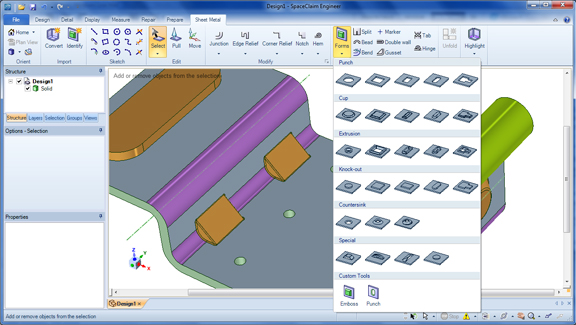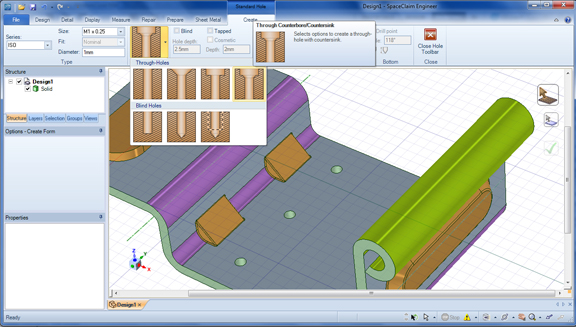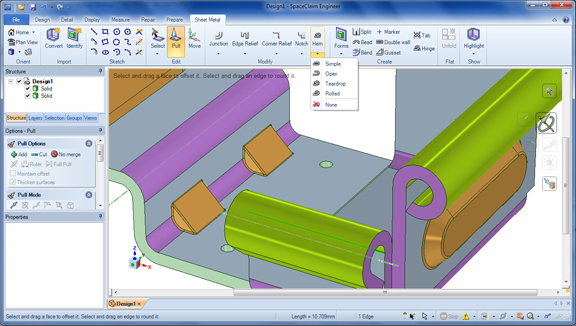October 6, 2011
The suffix plus in SpaceClaim 2011+, the latest upgrade from SpaceClaim Corp., may be a reference to the new sheet-metal functions added to the software. Many CAD users have discovered—like I did—that using direct modeling tools to create and edit sheet metals is a lot easier than using a classic parametric modeler. The ability to push, pull, and rotate sheet-metal plates and corners without worrying about their feature history gives you a lot more freedom in how you work. (You don’t, for example, need to worry about regeneration failure when you need to reposition a plate past the bend line you’ve defined previously.)
In SpaceClaim 2011+, you’ll find that you can drop many standard sheet-metal features (like gussets) into your design, slide them along a surface or an edge to position them, then anchor them with a click. With other features like double-sided walls, rolled edges, and teardrop-shaped edges, you can select the feature from the main menu, specify the surface or edge where you wish to apply the feature, and finish it with a click.
The software also makes it easy to split a plate into two (or more) regions, so you can continue to bend and rotate one region without affecting the rest. You may bend flat surfaces with additional features (like dimples) simply by drawing a bend line, specifying the bend direction, and executing it.
In 2011+, SpaceClaim added wizards and templates for standard holes, so you can pick and choose the type of holes you need (for instance, a counterbore hole that goes through the entire depth of the plate), drag it along a surface to position it (while previewing the hole in real time), then finish it with a click. The pattern creation and editing mechanism has also been refined so you get better previews before committing to a pattern.
Model display may be an area where SpaceClaim can use some improvement. SpaceClaim’s simple, straightforward interface is well-suited to those who wish to focus strictly on geometry, nothing else. But compared to rival software titles’ display options, some of which come complete with ground-plane reflections, environment maps, and integrated ray-tracing, SpaceClaim’s modeling window may seem sparse, especially if you want to evaluate your design’s aesthetic appeal alongside its geometry integrity.
SpaceClaim recently struck a partnership with Luxion, allowing SpaceClaim users to easily render their products and scenes in Luxion KeyShot. The integration comes via a KeyShot plug-in for those who own a KeyShot license. If you have KeyShot installed, SpaceClaim creates a KeyShot material library as an additional tab in the modeling window. After applying materials to your assembly, you’ll need to launch your design and scene in a KeyShot program window. This method works well if you don’t need to see your design with surface finishes and reflections till you’ve completed the design. It may be less than ideal if you want to see your design in a photo-realistic or semi-realistic mode while you’re modeling.
The direct-modeling battleground is about to see more skirmishes. PTC charges in with its Creo Elements/Direct Modeling Express (what was previously known as CoCreate, rebranded as a Creo app with a much more accessible interface). Siemens PLM Software continues to add features to its already robust Solid Edge with Synchronous Technology, now in 4th release (SE with ST4).
SpaceClaim 2011+ is an incremental release, perhaps a precursor to the major advancements scheduled for Version 2012. It continues to offer easy, intuitive direct modeling with a low learning curve, making the program ideal for those who feel traditional CAD is just too difficult to learn and master. With ANSYS as its partner, SpaceClaim continues to cultivate a fan base among analysis and FEA software users. Ease of use is SpaceClaim’s greatest asset and appeal for FEA specialists, who may not have extensive CAD knowledge but need to work with CAD models nonetheless.
For more, watch the video demonstration below:
Subscribe to our FREE magazine, FREE email newsletters or both!
About the Author
Kenneth Wong is Digital Engineering’s resident blogger and senior editor. Email him at [email protected] or share your thoughts on this article at digitaleng.news/facebook.
Follow DE








